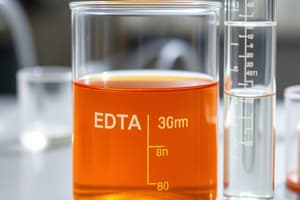Podcast
Questions and Answers
What is the primary issue with using Eriochrome Black-T in strongly acidic solutions?
What is the primary issue with using Eriochrome Black-T in strongly acidic solutions?
- It reacts with the sulphuric acid groups
- It loses its indicator properties
- It forms a precipitate with EDTA
- It polymerizes to a red brown product (correct)
In the context of EDTA titration, what is the significance of the pH range of 7-12?
In the context of EDTA titration, what is the significance of the pH range of 7-12?
- It is the range where the indicator is most stable (correct)
- It is the range where the phenolic groups are fully dissociated
- It is the range where the sulphuric acid groups lose their proton
- It is the ideal range for complex formation with calcium
Hard water is unsuitable for preparing drug solutions in the pharmaceutical industry due to?
Hard water is unsuitable for preparing drug solutions in the pharmaceutical industry due to?
- The presence of calcium and magnesium salts (correct)
- The high pH of hard water
- The inability to form a buffer solution
- The presence of iron salts
In the context of hard water analysis, what is the primary issue with using hard water in concrete making?
In the context of hard water analysis, what is the primary issue with using hard water in concrete making?
What is the primary purpose of using EDTA in the estimation of hardness of water?
What is the primary purpose of using EDTA in the estimation of hardness of water?
Flashcards are hidden until you start studying
Study Notes
Total Hardness
- Take 25 or 50 ml of a well-mixed sample in a conical flask
- Add 1-2 ml of buffer solution and 1 ml of inhibitor
- Add a pinch of Eriochrome black-T and titrate with standard EDTA (0.01M) until the wine red color changes to blue
- Note the volume of EDTA required (A)
- Run a reagent blank and note the volume of EDTA (B)
- Calculate the volume of EDTA required by the sample, C = A – B
Calcium Hardness
- Take 25 or 50 ml of sample in a conical flask
- Add 1 ml of NaOH to raise the pH to 12.0 and add a pinch of muroxide indicator
- Titrate immediately with EDTA until the pink color changes to purple
- Note the volume of EDTA used (A1)
- Run a reagent blank and note the volume of EDTA (B1)
- Calculate the volume of EDTA required by the sample, C1 = A1 – B1
Problems Based on Calorific Value
- Problem 1: If a sample of water contains 50 mgs of Ca2+ ions per litre, calculate its hardness in terms of CaCO3 equivalent
- Solution: Amount equivalent to CaCO3 = 50 × 100/40 = 125 mgs/lit
- Problem 2: A water sample contains 204 mgs of CaSO4 and 73 mgs of Mg(HCO3)2 per litre. What is the total hardness in terms of CaCO3 equivalent?
EDTA Titration
- EDTA forms colorless stable complexes with Ca2+ and Mg2+ ions present in water at pH 9-10
- Buffer solution (NH4Cl + NH4OH) is used to maintain the pH of the solution
- Eriochrome Black-T (EBT) is used as an indicator
- EDTA titration with EBT indicator involves a sharp color change from wine red to blue
Effects of Hard Water
- In sugar industry: hardness creates difficulties in sugar refining and crystallization of sugar, and the sugar becomes deliquescent
- In paper industry: calcium and magnesium salts interfere with the smooth and glossy finish of the paper, and iron salts interfere with the coloration
- In laundry: hard water causes wastage of costly soap and staining of iron salts
- In pharmaceutical industry: hard water is not suitable for preparing drug solutions
- In concrete making: hard water affects the hydration of cement and final hardening of cement
- In steam generation in boilers: hard water creates problems like scale and sludge formation, corrosion, priming and foaming, and caustic embrittlement
Studying That Suits You
Use AI to generate personalized quizzes and flashcards to suit your learning preferences.



